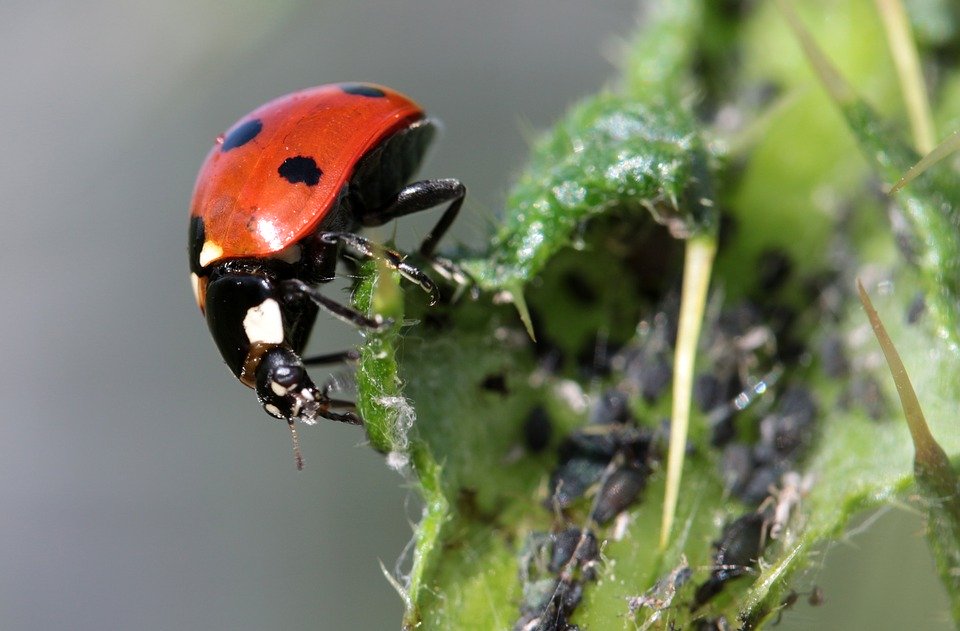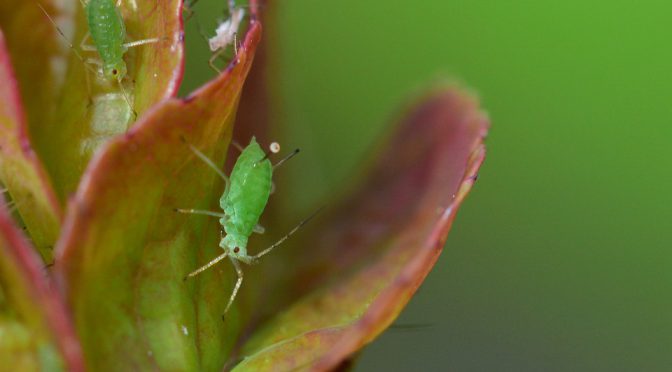Pests can be the bane of many gardeners’ existence and can be especially difficult to cope with if you’re new to gardening. Three pests that commonly make an appearance on a variety of plants include aphids, scale insects, and mealybugs. While they’re three different insects they all attack plants the same way, by feeding on its sap. You’ll find them along the stem and underside of the leaves where they suck the plant’s sap and drain it of important nutrients. They also secrete a substance called “honeydew” which can cause sooty mold to grow on your plants in severe cases.
You may have one of these insects feeding on your plants if you notice wilted, curled, yellow, or misshapen leaves, and water and nutrient issues aren’t the cause. You may also notice “honeydew” a sticky substance on the stem or leaves or the sooty mold that sometimes grows on it. These insects can also spread diseases between plants.
Aphids
Aphids are tiny, pear-shaped insects with long antennae. Different species are a variety of colors including green, brown, black, pink, white, yellow, and gray. They’re typically wingless though as populations increase many species have a form with wings that can be used to spread and create new colonies.
Scale Insects
Like aphids, scale insects are small and come in a variety of colors in eluding green, brown, tan, yellow, orange, and black. Unlike, aphids they lack antennae and just look like a tiny rounded shell. Their shell means that they’re hard to eliminate as adults because it protects them from most natural pest control methods. However, they’re much easier to eliminate at their “crawler” or nymph life stage before they’ve developed their hard shell.
Mealy Bugs
Mealybugs are white and fluffy and sometimes look like little tufts of cotton or mold. They may look larger when they’re all together in a clump.
How to Prevent/Eliminate Them

Attract or introduce their predators.
As mentioned in a previous post, ladybugs feed on these insects. Ladybugs also need to feed on pollen to reproduce. Including flowers like coreopsis, cosmos, and yarrow in your garden can help attract them. You can also let some of your vegetables and herbs like basil, dill, and lettuce go to flower for them. Ladybugs can also be purchased commercially and released into your garden.
Avoid over-fertilizing.
These insects are all much more likely to infest plants that have high nitrogen levels. Especially if you use chemical fertilizer, be judicious with the amount you use because it may do more harm than good!
Spray them off with water.
Especially if you catch an infestation early, you may be able to get rid of these insects by spraying them off with water.
Use a little soap.
Spraying your plants with a mixture of 1 tsp of dish soap in 1 quart of water is often effective. You should reapply the spray every 2-3 days for 2 weeks, ensuring you get all the surfaces of the plant.
Try neem oil spray.
Neem oil is a non-toxic, organic pesticide. Most neem oil products come with instructions for mixing (ie. 2 tbs of neem oil per 1 gallon of water). Try spraying all the surfaces of your plant once a day for 7-14 days.
Dab them with rubbing alcohol.
If the infestation is small you can remove these insects with a bit of rubbing alcohol on a cotton swab or rag.
Dust your plants with diatomaceous earth.
Diatomaceous earth is a powder made from the crushed remains of diatoms, tiny, fossilized aquatic organisms. It cuts through the exoskeleton of many insects and causes them to dehydrate. Just remember, it can harm beneficial insects as well. Avoid using it when plants are in bloom as it can harm pollinators.
Prune off the affected areas.
If you caught the infestation quickly you may be able to prune off the affected branches and burn them to prevent the insects from spreading.

